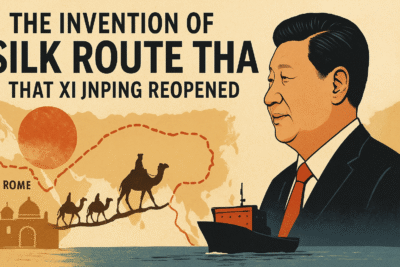
TFP 5 Explained
1.
Shubhanshu Shukla: The human side of Axiom mission and India’s space ambitions
What’s New?
While headlines have focused on Shubhanshu Shukla’s historic entry as the first Indian aboard the ISS, the story is also about the personal and national impact of his space mission: Shukla’s reflections from space and the broader implications for India’s space sector.
In his message, Shukla described adapting to microgravity as “like learning to live again, like a baby,” highlighting the profound psychological and physical adjustments astronauts face. He also emphasised the emotional weight of his 30-day pre-launch quarantine, underscoring the personal sacrifices behind such missions.
On June 25, Group Captain Shukla became the first Indian to live and work aboard the International Space Station (ISS), piloting the Axiom-4 mission launched by SpaceX’s Falcon 9 from Kennedy Space Center. The mission, commanded by former Nasa astronaut Peggy Whitson, includes crew from Poland and Hungary and will conduct around 60 scientific experiments, seven of which are Indian-designed, over a 14-day period.
Why does it matter?
Shukla’s mission is more than a national milestone; it’s a human story of resilience, adaptation, and inspiration. His journey, coming 40 years after Rakesh Sharma’s, aims to inspire a new generation of Indian scientists and students, much as Sharma’s did in 1984.
The mission’s seven Indian-led experiments—including growing methi and moong dal, and studying tardigrades in microgravity—demonstrate India’s growing scientific capability and international collaboration.
Why now? India has steadily advanced its space ambitions, with Isro’s lunar and Mars missions gaining global attention. This mission signifies India’s growing partnership with commercial space entities and highlights its ability to contribute to international scientific research.
How did it happen?
Axiom Space, a private company, partnered with SpaceX and international agencies to send a multinational crew to the ISS. Shukla’s selection followed rigorous training, and the mission aims to foster research in microgravity, biology, and materials science, with Indian-designed experiments taking centre stage.
How is it different?
Unlike earlier missions, this is a commercial, multinational effort led by Axiom Space and SpaceX, with India as a prominent partner. It signals a new era where Indian astronauts may become regular participants in global space research, not just rare exceptions.
So what?
This mission cements India’s status as a rising space power and inspires a new generation of Indian scientists and engineers. It also strengthens India’s global scientific collaborations and could lead to increased investment in space technology and research.
This mission’s real legacy may be its power to ignite curiosity and ambition among Indian youth, positioning India as a key player in the future of space exploration. It also highlights the human side of space travel, reminding us that behind every “first” is a story of personal courage and national aspiration.
2.
Israel-Iran ceasefire: A fragile peace in West Asia and aviation fallout for India
What’s new?
Beyond the military and diplomatic drama, a crucial angle is the ceasefire’s impact on India’s economy and aviation sector. The 12-day Israel -Iran conflict caused major disruptions: Indian airlines lost crores daily and thousands of passengers were stranded due to airspace closures and flight cancellations.
A ceasefire between Israel and Iran is reportedly “in effect” following weeks of escalating hostilities that threatened to destabilise the region. The truce comes after mediation efforts and international pressure, with both sides signalling conditional willingness to maintain peace.
The conflict had begun to impact global oil prices, disrupt international air travel — including stranding thousands of Indian passengers — and raised fears of a wider war drawing in major powers. Diplomatic intervention was urgent to prevent further humanitarian and economic fallout.
Why does Iit matter?
India depends heavily on West Asian air routes for both passenger and cargo flights. The conflict forced airlines to reroute, increasing costs, travel times, and logistical headaches. The truce, though fragile, is critical for restoring normalcy and limiting further economic damage.
How did this unfold?
As the conflict escalated, Indian airlines scrambled to adapt, with many flights grounded or diverted. The ceasefire, brokered after intense international pressure, allows for the gradual reopening of airspace and resumption of regular schedules.
The ceasefire was brokered through backchannel negotiations involving the United States and regional stakeholders. Both countries have made public statements about adhering to the truce, though mutual suspicion remains high.
So what?
For Indian travellers and businesses, the ceasefire is not just about regional peace—it’s about economic stability, affordable travel, and uninterrupted supply chains. The episode highlights India’s vulnerability to external shocks and the need for robust contingency planning in aviation and trade.
The ceasefire offers temporary relief but the underlying tensions persist. For India, stability in West Asia is crucial for energy security and the safety of its diaspora. Globally, the truce averts immediate escalation but the situation remains volatile.
3.
Dharti Aaba Janbhagidari Abhiyan (DAJA): India’s biggest tribal empowerment drive
What?
The Indian government has launched the Dharti Aaba Janbhagidari Abhiyan (DAJA), the largest tribal empowerment movement in the country’s history. Running from 15 June to 15 July 2025, it aims to reach over 5.5 crore tribal citizens across 31 states and union territories, covering more than 1 lakh tribal villages.
Why now?
Tribal communities in India have historically faced socio-economic marginalisation. DAJA reflects a renewed government focus on inclusive development, aiming to bridge gaps in education, healthcare, and economic opportunity for these populations.
Who?
Led by the Ministry of Tribal Affairs, DAJA involves grassroots outreach, welfare schemes, and direct engagement with tribal leaders. The campaign mobilises resources and personnel to address local needs and promote government schemes.
So what?
This initiative could transform the lives of millions, setting a precedent for large-scale, inclusive governance. It also signals India’s commitment to “Sabka Saath, Sabka Vikas” (development for all), with potential long-term benefits for national integration and social equity.
4.
Bihar to host its first nuclear power plant: A leap for energy security
What?
On June 25, Union Power Minister Manohar Lal Khattar announced that Bihar will soon have its first nuclear power plant, making it among the first six Indian states to adopt Small Modular Reactor (SMR) technology. The project’s location and capacity are yet to be finalised.
Why now?
Bihar is going to the polls later this year — political reason.
Official reason — India’s growing energy needs and climate commitments have spurred investment in clean, reliable power. Bihar, historically energy-deficient, stands to benefit from this modern, scalable nuclear technology.
How did it happen?
Following a formal request by the Bihar government, the Centre approved the SMR-based plant. SMRs are considered safer, quicker to deploy, and more flexible than traditional nuclear reactors, making them ideal for states like Bihar.
So what?
This marks a transformative step for Bihar’s infrastructure and could serve as a model for other states. It also boosts India’s push towards energy self-reliance and decarbonisation, supporting economic growth and environmental goals.
5.
Kirsty Coventry becomes first woman African Olympic Committee president
What?
Earlier this week, on June 23, Zimbabwean Olympic swimmer Kirsty Coventry was inaugurated as the first woman and first African president of the International Olympic Committee (IOC), succeeding Thomas Bach for an eight-year term.
Why now?
The IOC, under pressure to become more representative and inclusive, chose Coventry for her distinguished sporting career and leadership experience. Her appointment is seen as a progressive step for global sports governance.
How did it happen?
Coventry, a multi-medal-winning Olympian and sports administrator, was elected by IOC members and received the symbolic Olympic key in Lausanne, Switzerland. Her presidency is expected to focus on gender equity, youth engagement, and expanding the Olympic movement in Africa.
So what?
This is a watershed moment for gender and regional representation in global sports. Coventry’s leadership could inspire greater diversity in international organisations and promote sports development across Africa and beyond.
Bonus: 2 more news explained
1.
Heavy rainfall and flood alerts in Himachal Pradesh in Himalayas and Maharashtra in Deccan
What?
The India Meteorological Department (IMD) has issued an orange alert for heavy rainfall in Himachal Pradesh and a yellow alert for Maharashtra’s Raigad, Mumbai, Thane, and Palghar districts. Flash floods in Dharamshala have already claimed five lives, with several missing and rescue operations ongoing.
Why?
The monsoon’s intensity has increased, raising the risk of landslides, flash floods, and infrastructure damage in hilly and coastal regions. Local administrations are on high alert, with disaster response teams deployed.
How is it being managed?
State governments have instructed officials to remain vigilant, and rescue efforts are underway in affected areas. Authorities are urging residents to avoid risky zones and follow safety advisories.
So what?
With climate change intensifying weather patterns, such incidents are becoming more frequent and severe. This underscores the urgent need for better disaster preparedness, resilient infrastructure, and public awareness in vulnerable regions.
2.
Air India crash aftermath: DGCA finds safety lapses at major Indian airports
What?
India’s Directorate General of Civil Aviation (DGCA) has discovered multiple safety lapses at major airports, raising concerns about passenger safety and operational standards.
Why now?
Air India plane crash in Ahmedabad has triggered country-wide air safety checks by aviation authorities. With air travel rebounding post-pandemic, airport traffic has surged. The DGCA’s findings point to gaps in safety protocols, maintenance, and emergency preparedness at several key hubs.
How is it being addressed?
The DGCA has issued notices to airport operators and mandated corrective measures. Audits and surprise inspections are being ramped up to ensure compliance and accountability.
So what?
These lapses could undermine public confidence in air travel and expose passengers to avoidable risks, but fixing these now discovered safety loopholes enhance commuters’ confidence in the authorities’ due diligence. The aviation sector must prioritise safety reforms to match global standards and support India’s ambitions as an international aviation hub.





